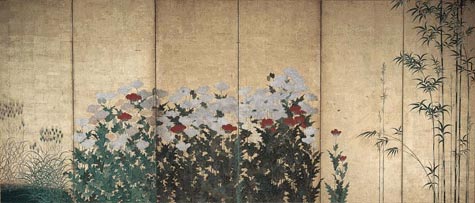| architecture |
| calligraphy |
| ceramics |
| clothing |
| comics |
| gardens |
| lacquerwork |
| literature |
| movies |
| music |
| painting |
| poetry |
| sculpture |
| tea ceremony |
| television |
| theatre |
| weaponry |
| thematic routes |
| timeline |
| the site |
context: painting > great schools > kano
Kano organization
It was important to be part of a school. Artists who moved on were still linked in the minds of others to their teachers, and being totally independent was barely an option - there was thought to be something deeply strange and suspicious about it, at least until late in the 18th Century, when being seen as eccentric became fashionable and cool.

|
Wheat Poppies and Bamboo by Kano Shigenobu, early 17th Century |
A school like this demanded business skills as well as artistic ability, to, in Guth's words, "operate a large workshop with many employees and carry out artistic commissions in a timely and cost-effective manner." Guth also suggests that the women of the family took some part in the running of the schools, but it's unclear whether there is real evidence for this, and they are almost entirely absent from any written records - except for when Motonobu married a Tosa woman, but that's a political story more than an art/business one.
A really successful school like the Kano would set up franchise branches - send a brother or two off to another part of the city, or another city entirely, and have them set up a school there. There were many branches in Edo during its early heyday. The heads of the four leading branches (including Tan'yu) had high status, that of samurai - these oku eshi received a stipend from the shogun, and were expected to show him their work every month. The heads of the next sixteen studios were designated omote eshi, and would receive some shogunal commissions. There were many more branches, in Edo and elsewhere, with official Kano school status, and in addition there were painters who had trained in Kano schools and then set up their own independent studio, but were still always identified as Kano artists. Tan'yu, the senior Kano during this period, could gain huge rewards for his work - his included a mansion!
most of the above is down to the excellent Christine Guth
